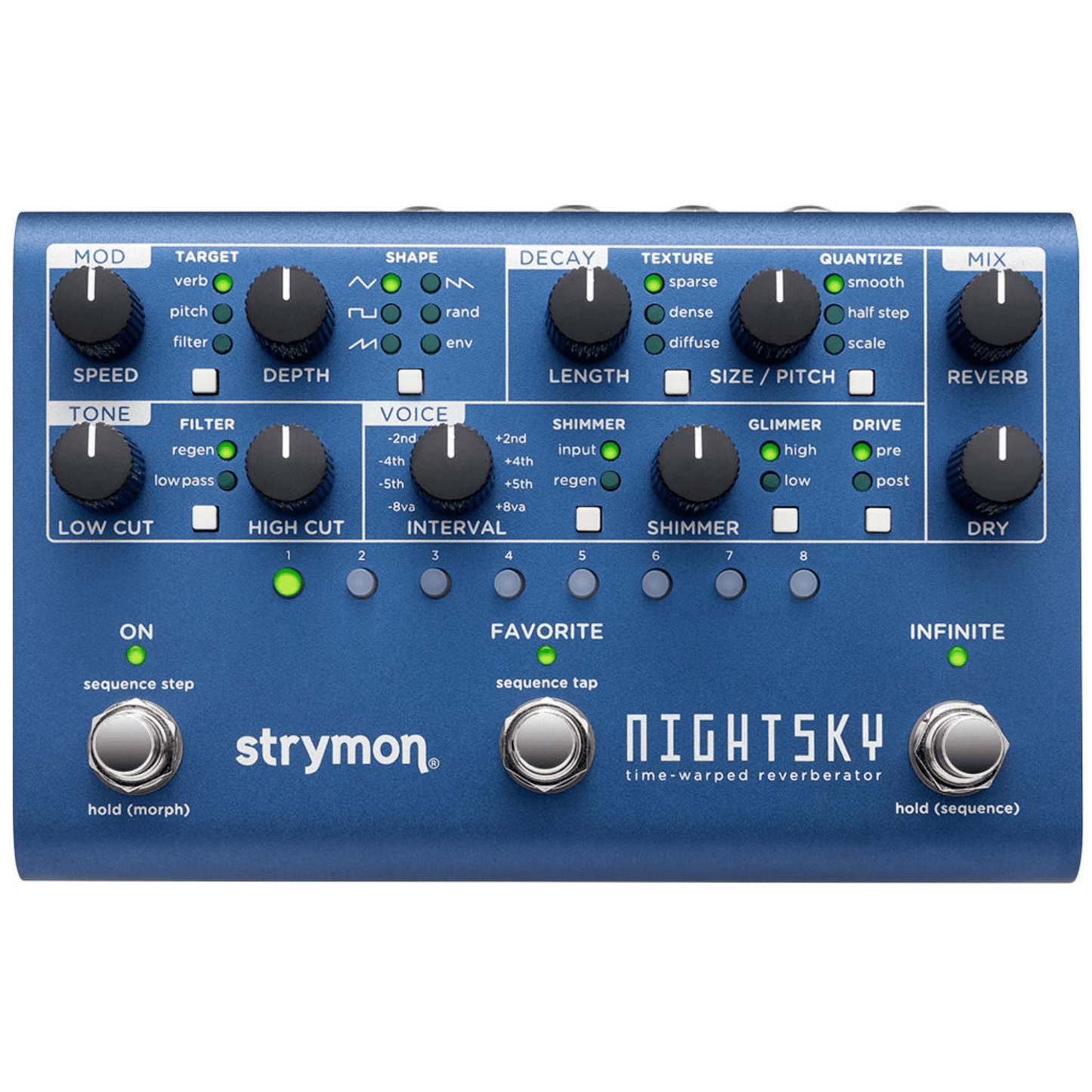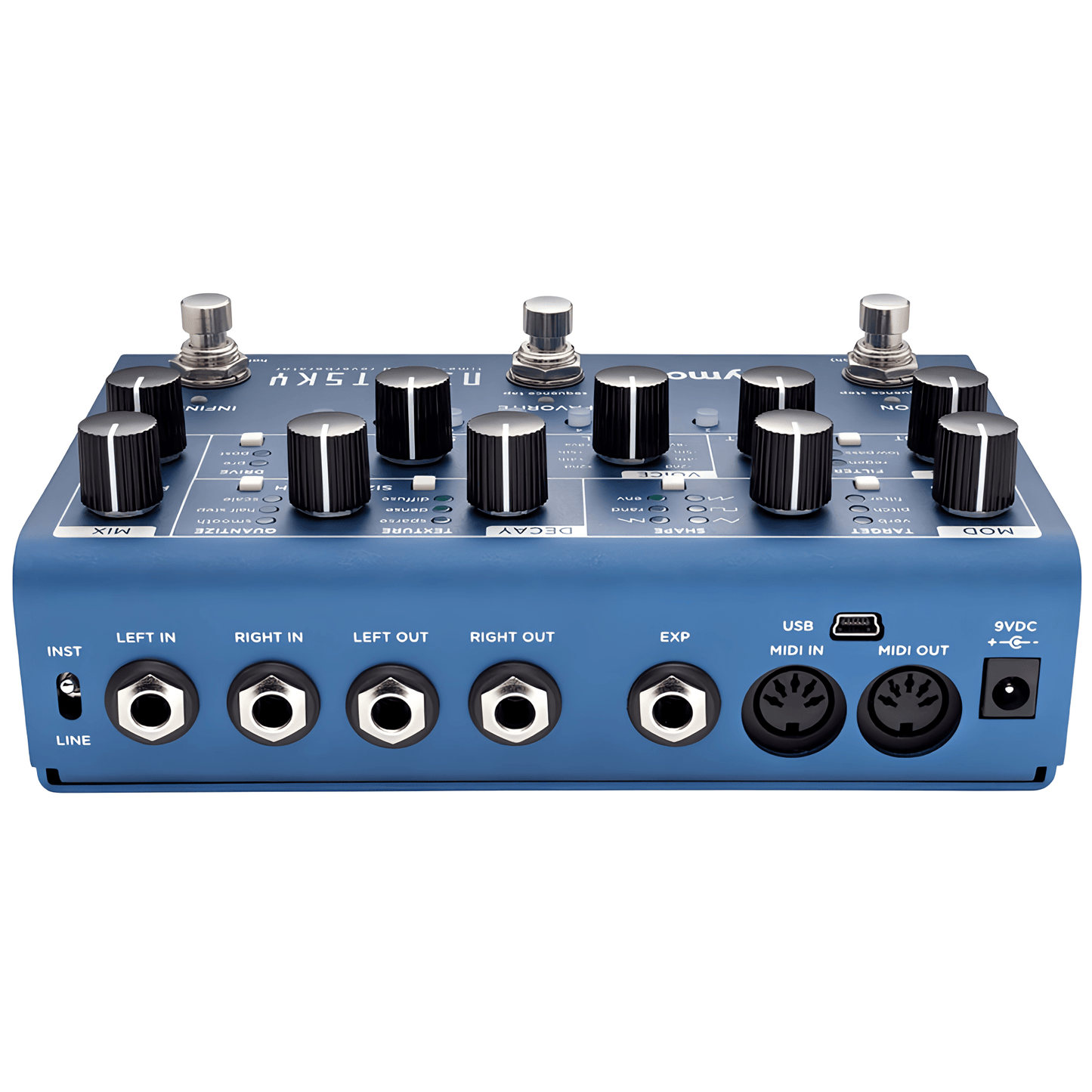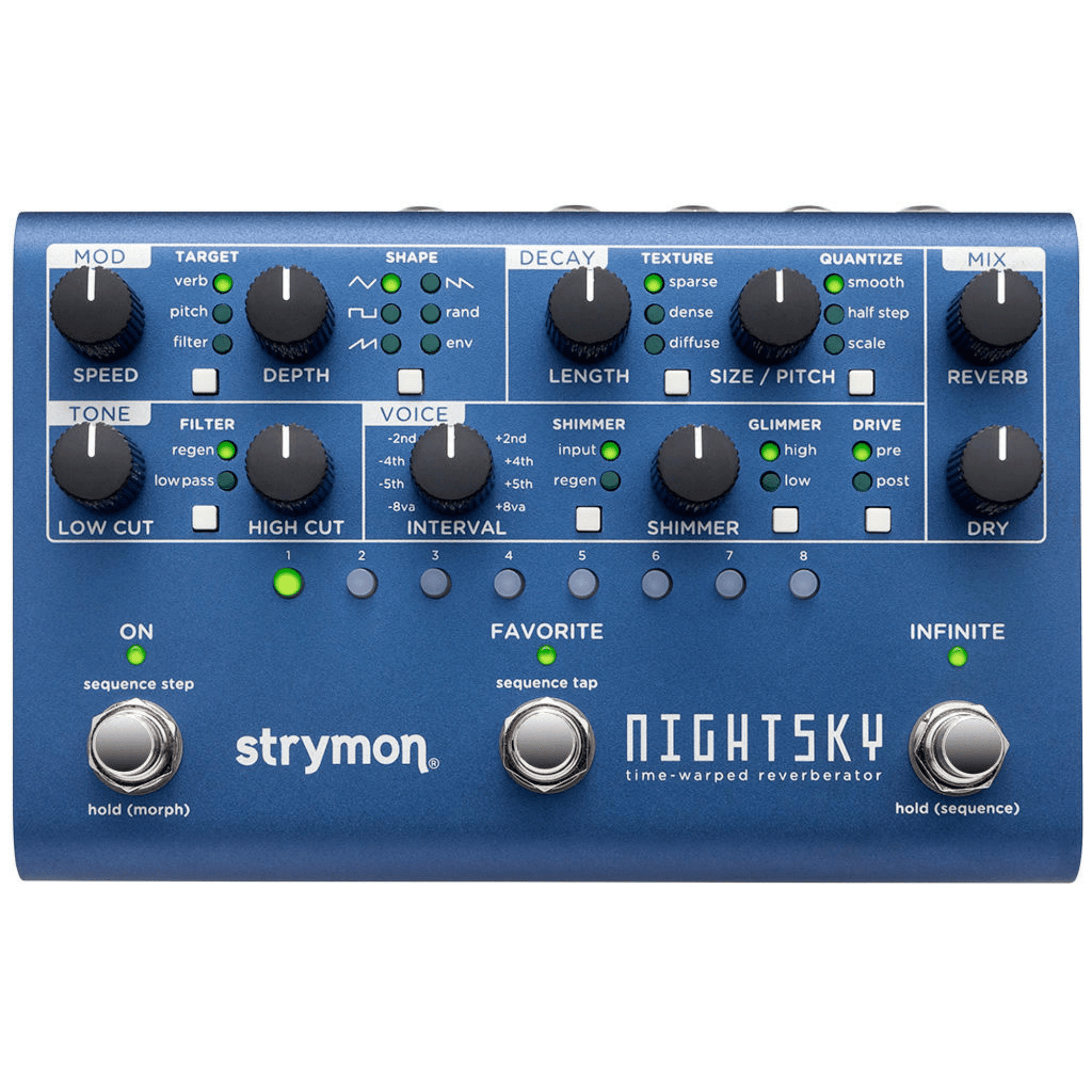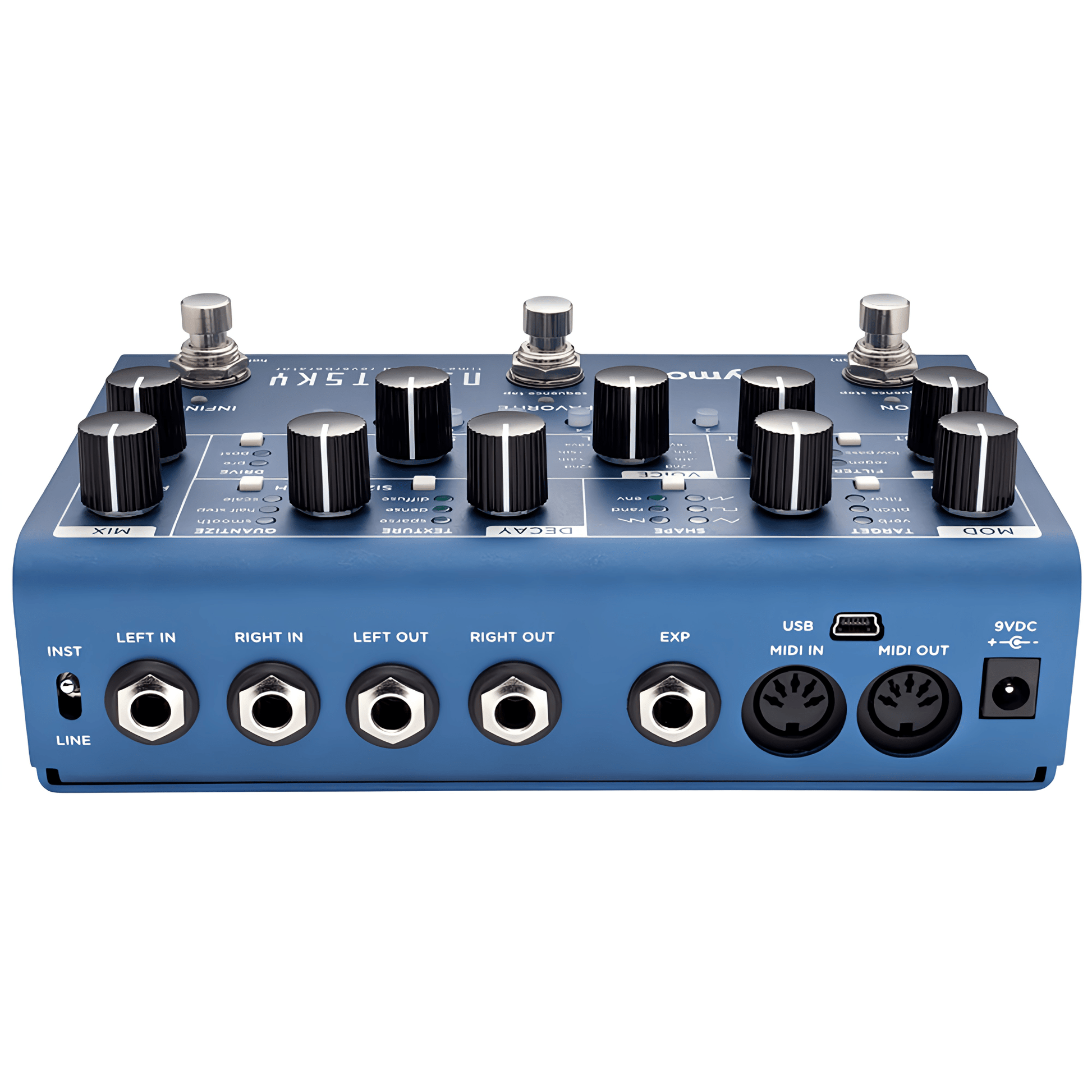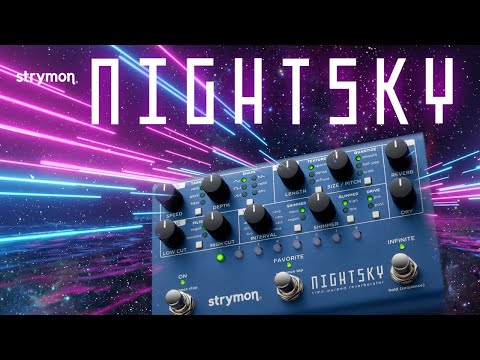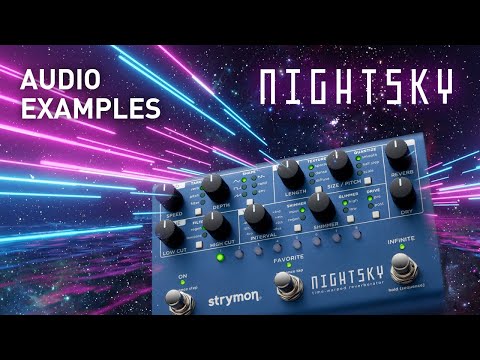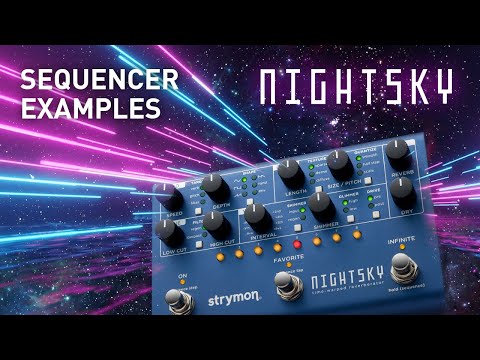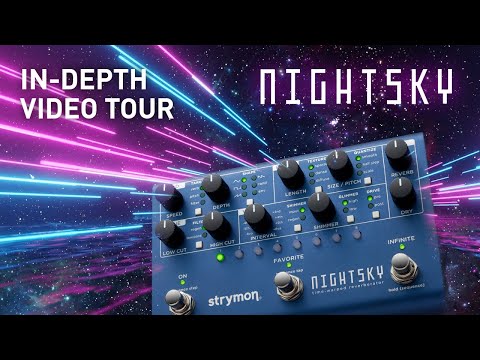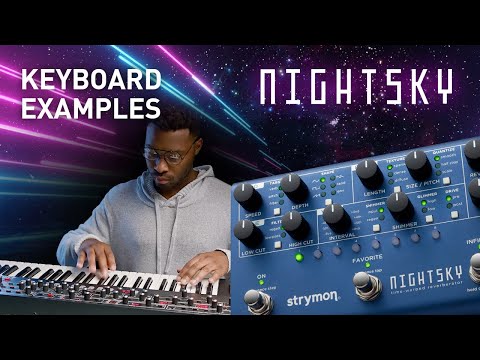Strymon
Night Sky
Night Sky
FREE 2Day Shipping
FREE 2Day Shipping
USA Free 2 Day Shipping
(Next Day in New England)
Canada NOW FREE
Worldwide 30USD Flat Rate*(Wherever you are)
Flat Rate means no additional charge for more than one pedal.
No Hassle Returns
No Hassle Returns
Pedal Features
Pedal Features
- Three selectable reverb types offer a wide variety of ambient textures
- MOD section with various waveforms to modulate the reverb or tone filters
- TONE section to sculpt the high and low EQ of the reverb
- VOICE section to enhance the aural spectrum of the reverb
- Adjustable SHIMMER for adding pitch shifting of up to +/- 1 octave to the reverb
- GLIMMER dynamically enhances high or low frequency harmonics for synth-like textures
- Pre or Post DRIVE to add saturated overdriven harmonics to the reverb
- Adjustable reverb core size to increase or decrease the space for reflections
- Independent REVERB and DRY level controls
- Step sequencer for programming rhythmic pitch variations of the reverb
- Access to 16 presets from the front panel and 300 presets via MIDI
- High impedance ultra low-noise discrete Class A JFET preamp stereo inputs
- Low impedance stereo outputs
- Input Level switch allows for both instrument and line level signals
- On, Favorite, and Infinite footswitches
- Expression pedal input allows the connection of an expression pedal, MultiSwitch Plus, or 1/4” to MIDI cable
- Full featured MIDI in/out supporting MIDI CCs, program changes, MIDI clock sync and more
- USB jack for controlling via MIDI from a computer or for performing firmware updates
- Analog dry path for a zero latency dry signal that is never converted to digital
- Premium JFET analog front end
- Ultra low noise, high performance 24-bit 96kHz A/D and D/A converters provide uncompromising audio quality
- Super high performance SHARC DSP
- 32-bit floating point processing
- 20Hz to 20kHz frequency response
- Audio Input Impedance: 1M Ohm
- Audio Output Impedance: 100 Ohm
- True Bypass (electromechanical relay switching) or selectable transparent Analog Buffered Bypass
- Strong and lightweight anodized dark blue aluminum chassis
- 9V DC power supply included
- Power requirements: maximum 9 volts DC center-negative, with a minimum of 300mA of current
- Dimensions:
- 4.5″ deep x 7″ wide x 1.75″ tall
- 114.3 mm deep x 177.3 mm wide x 44.5 mm tall
- Designed and built in the USA
Couldn't load pickup availability
Reverberant Synthesis Machine
NightSky is a reverberant synthesis workstation, and a powerful, hands-on experimental sound design platform. NightSky gives you real-time continuous control of reverb pitch/processing rate/core size, harmonics, and even a synth-like resonant filter with multiple modulation waveshapes, plus a step sequencer with variable glide. You haven’t heard a pedal like this before.
Three Reverb Textures: Sparse, Dense, and Diffuse.
NightSky gives you three distinct Reverb textures to choose from: Sparse, Dense, and Diffuse.
The Sparse reverb creates reflections that are far enough apart from each other to be audibly distinct.
Legato notes create a lush but pleasingly clean sound field, while staccato notes reveal individual echoes in a way that is well suited for sound design and special effects.
The Dense reverb texture is an immediate-response reverb with a smooth sound field, featuring sonic characteristics similar to a plate.
The Diffuse reverb creates a slow-building, atmospheric wash that excels at ambient, swell, and even reverse-like textures. The Diffuse reverb deconstructs and spreads transients over time to achieve its bloom-like effect.
Size/Pitch.
NightSky jettisons tradition and opens up a new universe of possibilities by using a variable rate process to expand and contract the reverb core size.
This changes the reflection density and response of the reverb while retaining the integrity of the audio within the reverb.
The result is a reverberated signal that can be transposed, sequenced and pitch modulated for interplanetary approval.
Sonically Beautiful Reverb Repitching.
Inspired by the classic shimmer effects pioneered in the ’80s using digital reverbs and pitch shifters, NightSky’s Shimmer voice is carefully created from the reverberated signal itself to generate maximum radiance and beauty.
Call forth deep, low ambient string sections with the octave down setting, or spacey ethereal textures with octave up.
In between the octaves are several musically interesting intervals available for shifting the harmonic structure of the reverb.
The Shimmer processing can be applied at the reverb input only, or can regenerate within the reverb core for ever-ascending or descending pitches as the reverb decays.
Custom Tailored Harmonic Spectrum.
Glimmer creates an enhanced harmonic spectrum using an optimally tuned dynamic resonant network.
Its high setting accentuates higher frequency harmonics, creating a washy, dreamy, ambient top end.
With Glimmer switched to its low setting, lower frequency harmonics are enhanced to alter the perceived harmonic structure and create mysterious synth-like textures.
Drive.
NightSky’s Drive feature generates saturated overdriven harmonics that can either react to the signal going into the reverb core, or dynamically distort the reverb’s output in a very interactive way.
When Drive is applied at the input to the reverb, digging in generates more distorted harmonics, so you can dynamically “play” the distortion going into the reverb core.
Placed on the reverb output, Drive acts as a soft-clipped limiter, reacting dynamically with the complexities of the decay of the reverb.
This can produce interesting distorted stereo panning effects, as reflections on either side of the stereo image surpass or recede below the amplitude necessary to generate noticeable distortion.
The harmonic complexity created by the Drive block is perfectly suited for sonic sculpting via NightSky’s low pass filter.
Synth-like Low Pass Filter and More.
NightSky features a beautifully tuned 4-pole 24dB/octave low pass filter with a user-selectable resonance amount for gorgeous synth-like filter sweeps of the reverb output.
The low pass filter is especially effective at shaping the distortion products from the Drive section.
When used with NightSky’s Modulation section this filter reveals the inspiring power of subtractive reverberant synthesis.
The low pass filter can also be swapped for a high cut filter that removes high frequencies from the regenerating reverb core to create a reverb that gets darker as it decays.
Also in NightSky’s TONE section is a low cut filter that removes low end content both at the output and in the reverb core.
Powerful Modulation Capabilities.
Add motion to your sounds with NightSky’s Modulation section.
Create slowly evolving ethereal textures, or push the limits of wildly experimental sound design.
Triangle, square, ramp, saw, random, and envelope wave forms can be used to modulate your choice of targets:
Modulate the delay lines within the regenerating reverb core, or modulate the size/pitch (process rate) of the reverb core.
Or, for very synth-like sounds, modulate the resonant low pass filter.
Morph.
NightSky’s Morph feature allows you to seamlessly go from one set of knob positions to another at the press of a footswitch, at any Morph speed you choose.
Use it to gradually vary modulation speed and depth, or morph from a subtle short-decay reverb to a huge, mysterious, modulated long-decay reverb.
You can morph between different size/pitch settings or even morph between shimmer intervals.
Turn up the resonance on the low pass filter and use Morph to sweep the filter’s center frequency, sweeping through audible harmonics as you go.
Morph settings are saved per-preset, making it a powerful live performance tool.
Sequence Your Reverb.
NightSky features a powerful and easy to use eight step sequencer.
Each step effectively changes the SIZE/PITCH setting and can be easily tuned in half step increments or to notes in the musical scale of your choosing, or can be tuned freely with no pitch quantization.
The sequencer can be set to advance a single step each time you press a footswitch, or can run automatically at a tapped tempo.
Individual steps can be instantly activated or deactivated as the sequence runs, and you can set a variable glide time for smooth pitch transitions between steps.
Sequences are saved per preset.
Infinite Sky.
NightSky’s INFINITE footswitch freezes the audio at the input to the reverb core, and any new audio can still be processed by the reverb on top of the frozen audio.
Not only does this allow you to create a lush ambient bed to play over, it offers a whole new world of possibilities when used in conjunction with NightSky’s sequencer.
Now you can repitch that frozen audio by predetermined intervals stored in your sequence, creating on-demand chord changes to play over, or single note sequences to set a groove.
Deep Editing.
NightSky’s front panel offers an abundance of control over your reverberated signal.
Should you desire to venture even further beyond the ordinary, there are several secondary parameters to add to your sound design toolkit.
Infinite Input Mode – With Infinite mode, select whether additional input signal gets processed by the reverb and sequencer or passes through unprocessed
Glide Time – Set the Glide (portamento) speed for the sequencer
Pre-Delay – Adjust pre-delay from 0 to 500ms
Scale Select – Choose from eight different scales when scale quantize is selected
Filter Resonance – Vary the resonance from gradual rolloff to sharp peaking response when low pass is selected
Glimmer Gain – Adjust the intensity of the Glimmer effect
Drive Gain – Set the intensity of the Drive effect
Morph Time – Adjust how quickly settings morph between each other
